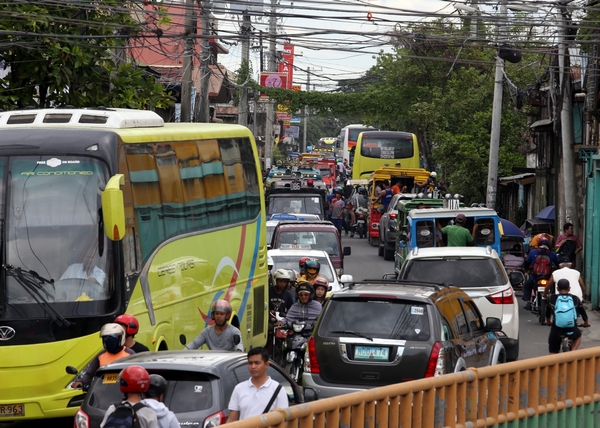
Tabada Street, one of the alternate routes for both north and southbound traffic, has been transformed into one messy stretch of both vehicular and commuter traffic with the continued closure of N. Bacalso Avenue.
Jica master plan identifies P209B worth of projects to improve traffic in Metro Cebu
A new bridge.
A circumferential road.
Two railway projects.
A unified traffic system.
These are the five “solutions” to the traffic problems of Metro Cebu, according to Japanese experts tapped to come up with a master plan on how to improve traffic in the metropolis.
But none of these projects was expected to be completed within the term of President Duterte, who was expected to step down in 2022.
The earliest completion will be in 2023 when the 4th bridge linking mainland Cebu and Mactan Island is expected to be operational.
The first of the three segments of Metro Cebu Circumferential Road (MCCR) will start construction by end of 2018, but no completion date has been announced.
The three others — the two railway projects under the Urban Mass Rapid Transit for the Coastal and Central Roads and the Area Traffic Control (ATC) System — have yet to undergo feasibility studies.
All five projects would cost at least P209.9 billion.
But if these were implemented, average travel speed of vehicles would increase from 30 to 40 km per hour, according to the Master Plan on Urban Transport System in Metro Cebu by Japan International Cooperation Agency (Jica).
This means that a travel of 21 km will only take 30 to 40 minutes.
With more roads available, volume of vehicles in major highways can be reduced to less than 80 percent of the roads’ actual capacity.
“If all the projects will be carried out according to the timeframe set by the master plan, this would bring the traffic congestion to the minimum. Dili mawagtang ang traffic because that is normal for a place with a growing economy, but that would be reduced significantly by these projects,” said Engr. Lynn Madrona of the Metro Cebu Development and Coordinating Board’s (MCDCB) Transport and Traffic Management subcommittee.
Madrona presented the master plan during a media briefing on Monday.
The MCDCB commissioned the study with Mega Cebu, a multi-sectorial consortium of private sector and government stakeholders created in 2011 that envisions sustained urban growth in Metro Cebu up to 2050.
In the preliminary study for the fourth bridge, Jica recommended that the bridge be placed at the Mandaue Coastal Road traversing 640 km to the National Highway near the Mactan-Cebu International Airport in Lapu-Lapu City.
This bridge is expected to cost at least P6.9 billion and will be operational by mid of 2023.
The MCCR is a 21-km bypass road from Naga City in the south to Danao City in the north.
It has three segments — segment 1 covers Talisay City to Mandaue City; segment 2 is from Consolacion town to Danao City; and segment 3 spans from Naga City to Minglanilla town.
Segment 1 will start construction by fourth quarter. A budget of P300 million was released this year although the entire project would cost at least P40 billion.
Part of the road project is a 2-km tunnel which will be part of segment 1.
The MCCR might also overlap with another flagship project of the Duterte administration — the Metro Cebu Expressway (MCE), which costs P50 billion.
It is envisioned to be a six-lane expressway that will also connect Danao to Naga.
Like the MCCR, the MCE is also divided into three segments. The only difference between the two is the segment 3 since the expressway is longer than the circumferential road.
Madrona said they would adopt the segment 1 of MCE since the Department of Public Works and Highways, which is the implementor of the expressway, already has a feasibility study.
Both the DPWH and MCDCB were also expected to meet and merge the two projects as one.
According to Jica study, the cost of MCCR would go up if the proponents would decide to adopt the DPWH design of the MCE’s segment 3.
The URMT system, on the other hand, will have two railway projects — one going to the central line or around the urban center and another going along the coastal line of Metro Cebu.
The feasibility study on the central line railway will start in 2019 and will be completed in one year.
Based on the tentative timeline of the project, the detailed engineering design of the central line railway would start in 2021 while the construction phase would be from 2023 to 2027.
The test run of the UMRT Central Line would be in 2027 and would be operational in 2028.
The central line would traverse from Talisay City in the south to Consolacion town in the north and would cost about P105.9 billion.
The coastal line, however, will take a little longer since its feasibility study was expected to start in 2022 and the detailed engineering design in 2024.
Its construction would start in 2026 and would be completed in four and a half years.
The coastal railway will cover the coast of Cebu mainland to Mactan Island.
The UMRT Coastal Line would cost P47.1 billion including the construction of the railway bridge from mainland Cebu to Mactan Island.
In the meantime, the ATC system will cost about P10 billion and is expected to put up a unified traffic control system in Metro Cebu.
The ATC is composed of synchronized traffic signaling system and traffic information system.
ATC had been endorsed by the Regional Development Council in Central Visayas to the Department of Transportation so budget for its feasibility study would be included in the 2019 budget.
Disclaimer: The comments uploaded on this site do not necessarily represent or reflect the views of management and owner of Cebudailynews. We reserve the right to exclude comments that we deem to be inconsistent with our editorial standards.
